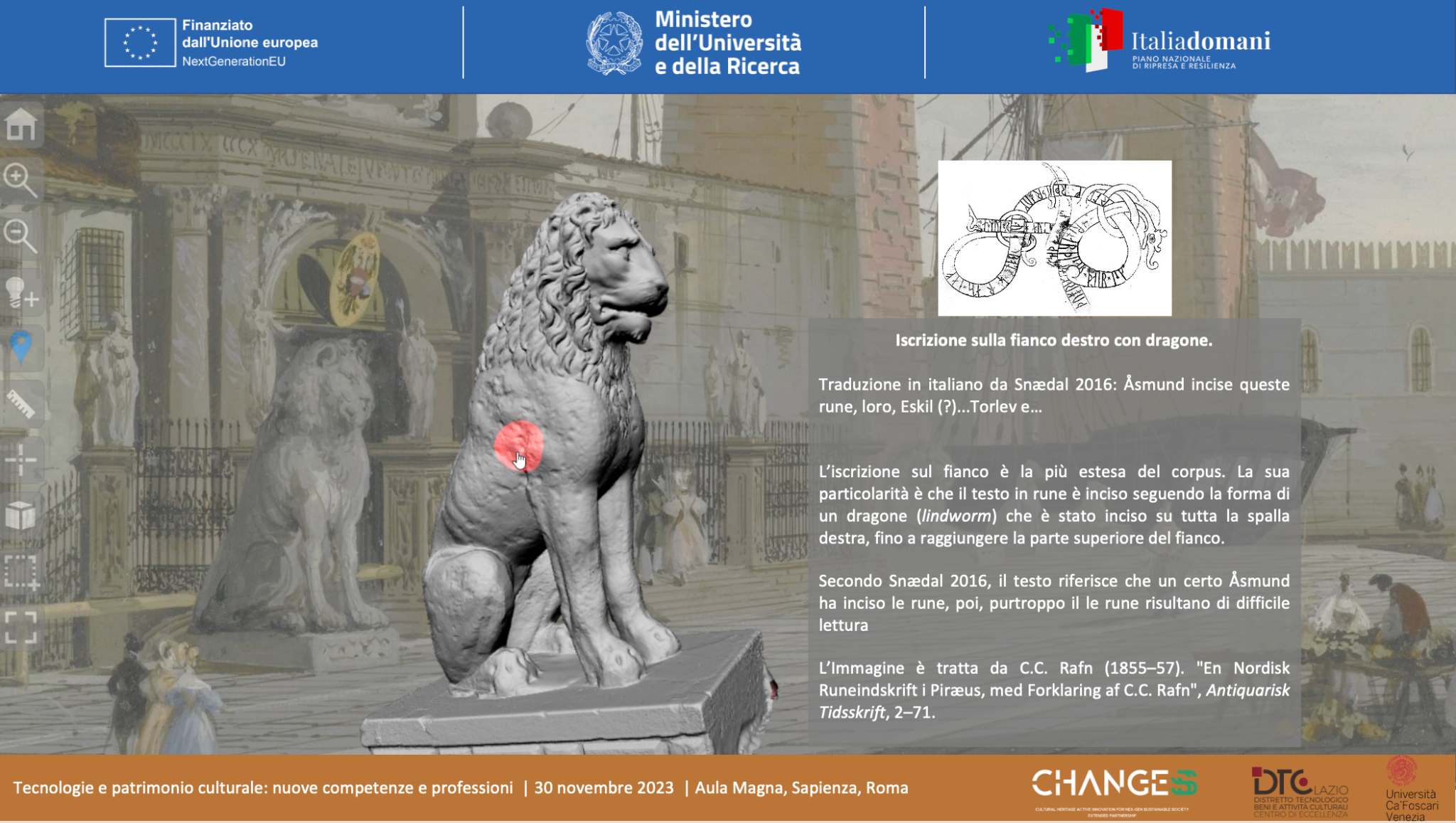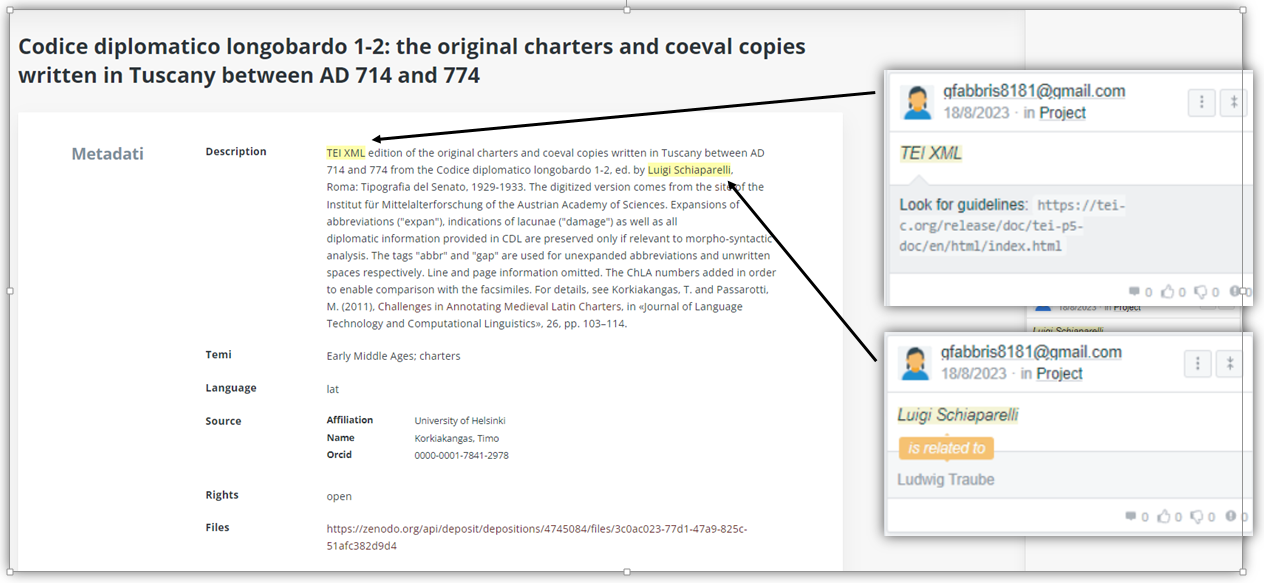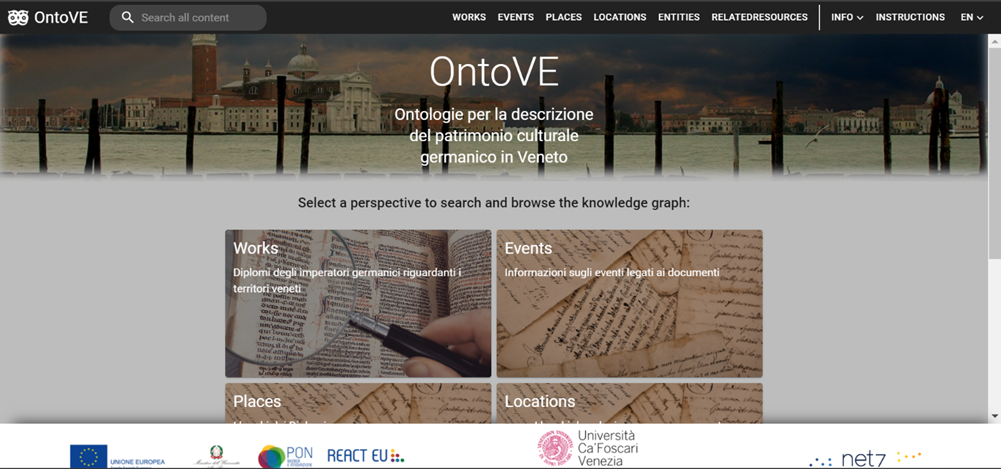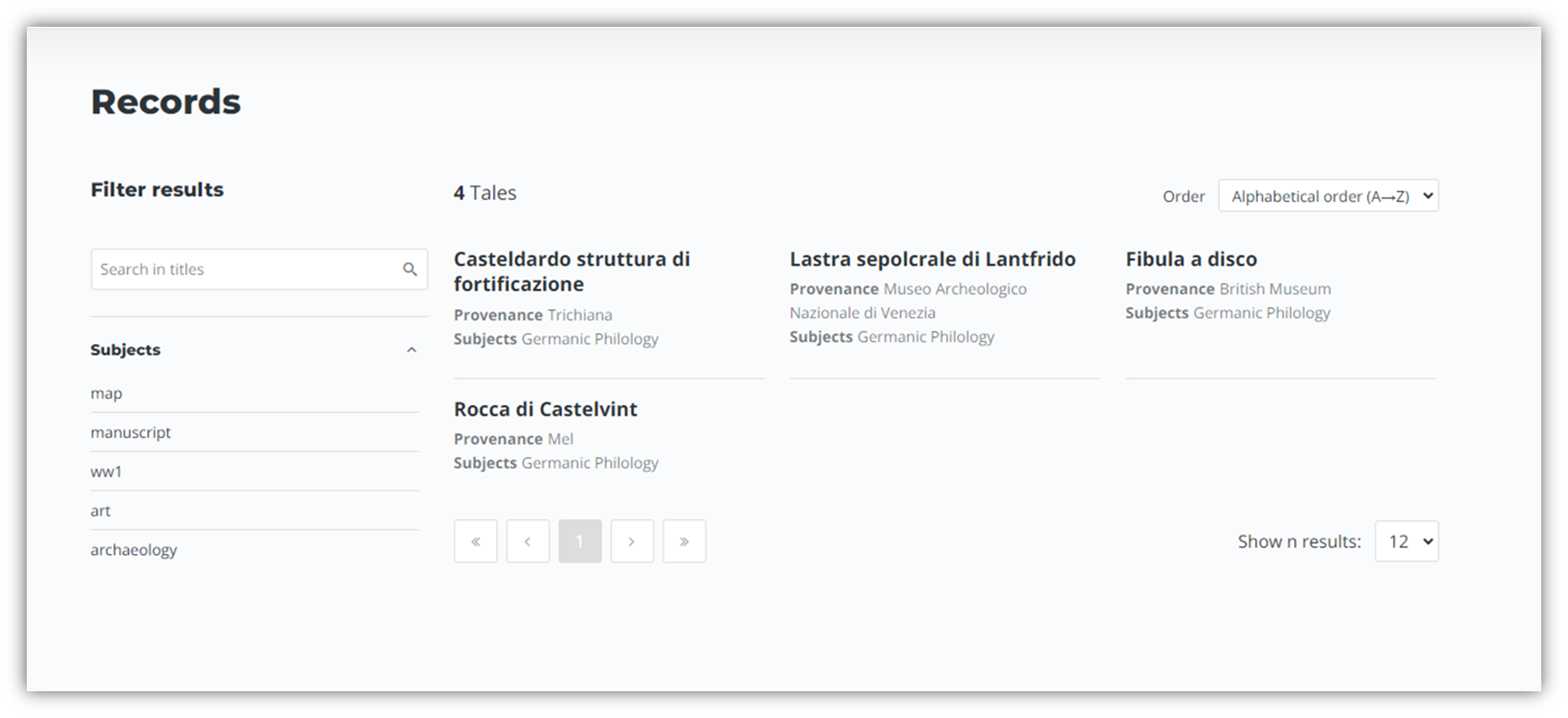
The goal of this paper is to present three case studies aimed at the valorization of the Italian and Germanic Cultural Heritage in Venice and in Italy by making the data available not only to the academic compartment, but also to the wider community, in order to reinvent approaches to the accessibility of Cultural Heritage. We are focusing on making Cultural Heritage easily appreciated and understood by a wider audience, in the spirit by Bellanca et al. (2022) and the Faro Convention (2005). In fact, the three case studies illustrated have as their common denominator the retrieval, reuse of metadata and the digitization of Germanic and Italian Cultural Heritage, according to the FAIR principles and current metadata standards, by creating an aggregator, ontologies and databases hosting digital projects and 3D models.
The first case study is embedded within the PNRR (2021-2026) Hub CHANGES-Crest, Spoke 9 led by Università Ca’ Foscari Venezia and it is titled “Il Leone del Pireo presso l’Arsenale di Venezia: un progetto digitale partecipativo”: it concerns a 3D digitisation of a famous Greek zoomorphic statue (4th cent. BC) at the Venetian Arsenal which bears three runic inscriptions very likely engraved by Varangians (10-11th cent. AD). The ultimate goal is to make available and easily accessible to a wider audience the visualization of the 3D mapping of the statue and its texts, which have become increasingly difficult to read and many people (residents and tourists) did not have any hint about. The 3D digitization applies photogrammetry methods and has been produced with Agisoft Metashape Professional. The open-source framework 3DHOP by Isti-CNR allows to visualize the 3D object and link to textual and visual information to the object by means of the hotspot feature (cf. Figure 1). The selected information from the literature regarding the inscriptions is displayed in a way that is both scientifically correct and appealing. The readings and interpretations provided by the scholars through centuries, including our own proposal, are encoded and available in TEI/XML format. The metadata have been encoded in compliance with METS guidelines. We plan to make the project available to the wider audience in local institutions related to the history of the city, and, for its long-term preservation, in democratic infrastructures, as CLARIN-IT might be. Moreover, a 3D printing of the statue and a booklet for vision-impaired audience have been printed.
The other two case studies are funded by PON Ricerca e Innovazione 2014-2020 Asse IV “Istruzione e ricerca per il recupero – REACT-EU and have as their domain the Italian Cultural Heritage and the Germanic Cultural Heritage in Venice and the neighboring territories respectively. With the second case study, CHIt, an aggregator is being developed for the retrieval of online digital objects belonging to the Italian Cultural Heritage from different providers. The keyword of this work is reuse, both of data and of tools. In particular, the data and metadata are retrieved from Europeana, Zenodo and GitHub through APIs and from OntoVE (see below) via a SPARQL query. On the other hand, all the tools chosen are open-access. These comprise Muruca for the front-end, Pundit for the annotation of texts and EVT as visualization software. The incoming metadata retrieved are mapped to offer a uniform consultation and formatted according to the DCMI to enhance interoperability thanks to the adoption of an international standard. In this way, the selected resources gathered from different platforms can be aggregated in a single searchable and interoperable environment. Moreover, the integration of the visualization and annotation tools allow to engage the user and offer a personalized exploration and use of the resources (cf. Figure 2).
The third case study, OntoVE, consists in the creation of ontological modules for the description of Germanic Cultural Heritage and bibliographic items linked to the Veneto region. The items to be included date back to the first attestations of the Gothic and Lombard periods (from the 5th century AD onwards, Villa 2006) and we aim to include moreover items up to the Early Modern period, e.g. related to the Fondaco dei Tedeschi (cf. Braunstein 1987, Häberlein 2010). The project reuses established ontologies, such as CIDOC-CRM, v. 7.1.2 (Bekiari et al. 2022), ArCo (Carriero et al. 2019), LRMoo, v 0.9.6 (Bekiari et al. 2023) and Bibframe (for the mappings between LRMoo’s former version FRBRoo and Bibframe, cf. Zapounidou et al. 2013, and for partial alignment between CIDOC-CRM and ArCo cf. Carriero et al. 2019, Sartini et al. 2023). This way, the ontological modules devised are interoperable with both national and international standards (cf. the Github documentation available at https://chideba.github.io/ontove/ontove.html ). The Knowledge Base will not only be made available through a SPARQL Endpoint (built with Apache-Jena-Fuseki-4.7.0), but will be made available to a wider audience through a dedicated User Interface, built upon the Sampo UI model (Ikkala et al. 2022). This User Interface presents the data according to different search perspectives, making them available via an intuitive search facet (cf. Figures 3 and 4).
Furthermore, ongoing collaboration between the latter two case studies (cf. De Bastiani-Fabbris 2023) has resulted in a further visualization output for the dataset produced within the OntoVE project, which consists in a further intuitive search interface to discover, locate and annotate information about Cultural Heritage items of interest to the wider public (cf. Figure 5). In this way, users can interact with the data of OntoVE together with the other resources aggregated in CHIt and they can annotate them, enhancing the invention and reinvention of new meanings and experiencing further approaches to the accessibility of Cultural Heritage. The outcomes of both projects will be available through a dedicated web domain, under implementation.
Concluding, the three case studies tackle the valorization of Cultural Heritage through different perspectives guided by the Digital Paradigm and by the Faro Convention. The models presented aim to involve the active engagement of users, also taking into account the different interests and specificities of the various target audiences. We argue that it is becoming increasingly topical to make such projects and their metadata accessible to an increasingly wide and heterogeneous audience.

Figure 1 Visualization of the hotspots using 3DHOP. This is a screenshot from Buzzoni and Peratello’s presentation “Il Leone del Pireo Arsenale di Venezia: metodi e strumenti digitali per una fruizione partecipativa di testi e immagini” at Convegno DTC Lazio - CHANGES “Tecnologie e Patrimonio Culturale. Nuove Competenze e Professioni”, Sapienza Università di Roma, November 30, 2023 (Rome).

Figure 2 Visualization and Annotation of a Zenodo resource through CHIt aggregator

Figure 3 OntoVE User Interface (built upon Ikkala et al. 2022)

Figure 4 OntoVE Search facet

Figure 5 Visualization of the OntoVE dataset through CHIt
References
Bekiari, Chrysoula / Bruseker, George / Canning, Erin / Doerr, Martin / Michon, Philippe / Ore, Christian-Emil / Stead, Stephen / Velios, Athanasios (2022): Definition of the CIDOC Conceptual Reference Model, Version 7.1.2.
Bekiari, Chrysoula / Doerr, Martin/Le Bœuf, Patrick / Riva, Pat (2023): LRMOO object-oriented definition and mapping from IFLA LRM, Version 0.9.6
Bellanca, Calogero / Mora Alonso Munoyerro, Susana/ Antonini Lanari, Cecilia (2022): “Accessibility of cultural heritage ” In: OCHRONA DZIEDZICTWA KULTUROWEGO. - ISSN 2543-6422. - 13, pp. 51-68. [10.35784/odk.2941]
Buzzoni, Marina / Peratello, Paola (2023): “Il Leone del Pireo Arsenale di Venezia: metodi e strumenti digitali per una fruizione partecipativa di testi e immagini” In: Convegno DTC Lazio - CHANGES “Tecnologie e Patrimonio Culturale. Nuove Competenze e Professioni”, Sapienza Università di Roma, November 30, 2023 (Rome).
Carrero-Pazos, Miguel, / Espinosa-Espinosa, David (2018): “Tailoring 3D modelling techniques for epigraphic texts restitution. Case studies in deteriorated roman inscriptions.” In: Digital Applications in Archaeology and Cultural Heritage, 10, https://doi.org/10.1016/j.daach.2018.e00079
Carriero, Valentina Anita / Gangemi, Aldo / Mancinelli, Maria Letizia / Marinucci, Ludovica / Nuzzolese, Andrea Giovanni / Presutti, Valentina / Veninata, Chiara (2019): “ArCo: The Italian Cultural Heritage Knowledge Graph” In: The Semantic Web – ISWC 2019. ISWC 2019. Lecture Notes in Computer Science, vol 11779. Springer, Cham. https://doi.org/10.1007/978-3-030-30796-7_311779:36–52
De Bastiani, Chiara / Fabbris, Giulia (2023): “Collaboration within a shared digital paradigm: opportunities and outcomes” , Zenodo https://zenodo.org/records/8198555, Alliance of Digital Humanities Association, ADHO23.
Häberlein, Mark (2010): “Der 'Fondaco dei Tedeschi' in Venedig und der Italienhandel oberdeutscher Kaufleute (ca. 1450-1650)” in Körner, H. M. and Schuller, F. (ed), Bayern und Italien. Kontinuität und Wandel ihrer traditionellen Bindungen. Lindenberg im Allgäu, pp. 124–139.
Ikkala, Esko/ Hyvonen, Eero / Rantala, Heikki / Koho, Mikko (2022): “Sampo-UI: A Full Stack JavaScript Framework for Developing Semantic Portal User Interfaces” In: Semantic Web 0 (0) 1 1, IOS Press
Sartini, Bruno / Baroncini, Sofia / van Erp, Marieke / Tomasi, Francesca / Gangemi, Aldo (2023): ICON: An Ontology for Comprehensive Artistic Interpretations. ACM J. Comput. Cult. Herit. 16, 3, Article 59 (August 2023), 38 pages. https://doi.org/10.1145/3594724
Villa, Luca (2006): “Le tracce della presenza gota nell'Italia nord-orientale e il caso dell'insediamento di S. Giorgio di Attimis (UD)” in Buora, M. and Villa, L. (ed) Goti nell'arco alpino orientale. Trieste: Editreg srl, pp. 147–176.
Zapounidou, Sofia / Sfakakis, Michalis / Papatheodorou, Christos (2013): “Preserving Bibliographic Relationships in Mappings from FRBR to BIBFRAME 2.0”. In: Kamps, J., Tsakonas, G., Manolopoulos, Y., Iliadis, L., Karydis, I. (eds) Research and Advanced Technology for Digital Libraries. TPDL 2017. Lecture Notes in Computer Science(), vol 10450. Springer, Cham. https://doi.org/10.1007/978-3-319-67008-9_2
Sitography
CHANGES-Crest Spoke 9, Università Ca’ Foscari Venezia, https://pric.unive.it/progetti/spoke-9-changes/changes
EVT (Edition Visualization Technology), http://evt.labcd.unipi.it/
Faro Convention, 2005 (Convention of the Value of Cultural Heritage for Society),
https://www.coe.int/en/web/culture-and-heritage/faro-convention
Italia Domani, il Piano Nazionale di Ripresa e Resilienza (2021-2026), https://www.italiadomani.gov.it/content/sogei-ng/it/it/home.html
Library of congress: Bibliographic Framework Initiative, Bibframe Vocabulary 2.0, https://www.loc.gov/bibframe/implementation/
METS (Metadata Encoding and Transmission Standard), https://www.loc.gov/standards/mets/
Ministero dell’Università e della Ricerca (2014-2020): Piano Operativo Nazionale PON, Asse IV Innovazione, http://www.ponricerca.gov.it/opportunita/react-eu-contratti-di-ricerca-innovazione-e-green/
Muruca, http://murucaracconta.muruca.cloud/
Pundit, https://thepund.it/
3DHOP (3D Heritage Online Presenter), https://3dhop.net/
Ministero dell’Università e della Ricerca (2014-2020): Piano Operativo Nazionale PON, Asse IV Innovazione, http://www.ponricerca.gov.it/opportunita/react-eu-contratti-di-ricerca-innovazione-e-green/
Muruca, http://murucaracconta.muruca.cloud/
Pundit, https://thepund.it/
3DHOP (3D Heritage Online Presenter), https://3dhop.net/